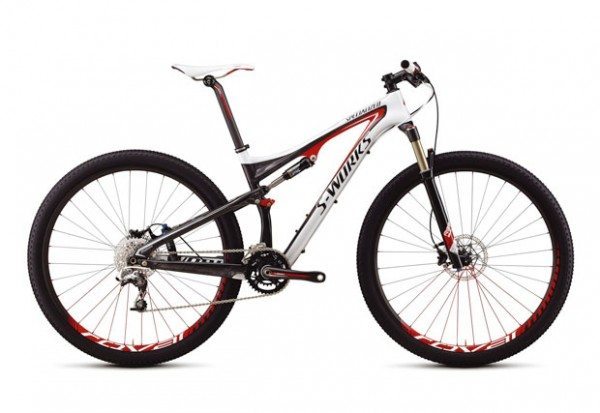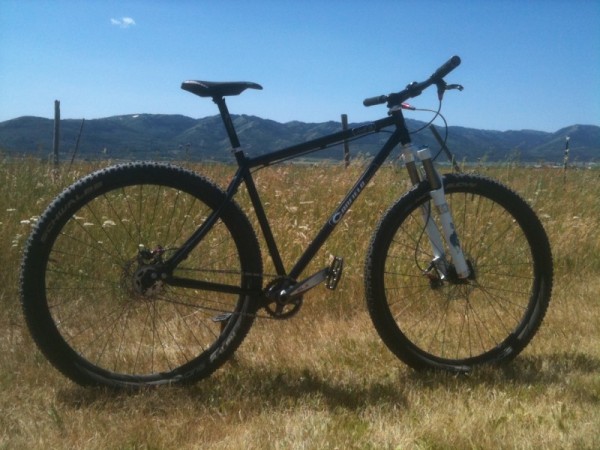If you ride bikes and haven’t heard any debate over 29ers, you either (A) have been cryogenically frozen for the past few years, or (B) live in an isolated mountain cabin and ride actual wooden wagon wheels.
But if you aren’t in either of these camps, you probably know that 29ers are staging a blitz of the mountain bike industry. A lot of riders love ‘em and a lot of riders hate ‘em, for a lot of different reasons. Will 29ers establish themselves as a mainstay on the scene, or will they simply turn into a cult favorite? For those of you who are frozen, have belly-length beards, or are just plain confused, we’ll clear up some of this mess.

Mountain bike design is a game of geometry. In an ideal world, the geometry of the bike between your legs should complement the trail that’s below them. You want something aggressive, nimble, and sturdy for DH, and something light, steady, and powerful for XC. For these two purposes, riders usually use two different bikes. In fact, bikers often use different types of bikes for different situations. You wouldn’t take your dirt jump bike on an XC trail would you? What about your downhill bike on a road ride?
Enter the 29er (for the uninitiated, a mountain bike with 29” wheels as opposed to 26” wheels), the hottest, trendiest trend that the industry has seen since … well, who knows? Full suspension? Disc brakes? This is where the debate begins.
It appears that 29ers began their development around 15 years ago, the idea spawning from any number of larger tires (e.g., cyclocross, 700c) and manufacturers looking to combine different elements of bike design. Then, in some kind of crazy mix-up in which no one can either remember the details—or just don’t care to—Gary Fisher, WTB, and cyclocross had a child that would become the 29er as we know it today. It appears to be a case of dedicated industry folks putting their heads together to enhance the sport of mountain biking, and not just some crazy marketing scheme to get people to buy bikes.
And while 29ers are all the rage now, from the beginning of their existence (however convoluted that origins story may be), they’ve simply had terrible geometry. Essentially, larger wheels were thrown onto smaller frames, and out the door they went.
This led to a number of problems. Bikes designed like this are unbalanced and very slow in the rear due to a long rear triangle. The front is then twitchy and unstable, with an excessively steep front end married to an overly long stem. It also has a short front-center with a too-long chainstay. And yet, there is good news: traditional 29er geometry actually works really well on smooth, less-than-gnarly trails (29ers have a few XC World Cup podiums to date, but these have been the exception, not the rule). They’re fast once they’re up to speed, provide good grip on all parts of the trail (due to more tire surface area on the ground), and allow for excellent roll-over. These traits naturally make for good XC rides. The bad news, however, is that on steep, rough, technical trails (read: DH), they’ve traditionally been clunky and hard to maneuver.
So, yeah, 29ers do some things well, and 26ers do some things well, too. But 29ers are a relatively new technology and haven’t been perfected yet. We’re still in the trial phase.
So how can we settle our differences? Well, we should first look at the warring factions.
The dichotomy between the 29er riders and the 26er riders comes from differences in (1) riding styles and (2) preferred trail types.
If you ride aggressively on gnarly trails—bunny hopping rocks, hitting doubles, and finding the deep lines on technical trails—the 26er is, in most cases, still the bike you want. (More on this later.) If you like to cruise, hit XC tracks, climb a lot, and flow through rollers, the 29er is more up your alley. And, incidentally, this portion of riders makes up a large part of industry sales, which is why so many 29ers are rolling around these days.
“Aggressive trail riders see these bikes only working well on smooth, mellow trails, and bad-mouth them,” Marshal Olson, BLISTER mountain bike reviewer, said. “The rider’s that like this sort of trail find the wheels to roll fast and for the bikes to hold momentum well while coasting, and love them—but are insulted by aggressive riders making fun of the 29’er.”
Aggressive DH riders like the 26ers because the geometry is designed to tackle trails fast and forcefully. To accomplish this, the geometry should have a slackened head angle, a low bottom bracket, a relatively short chainstay with a fairly long front-center, and a modest length stem.
“As long as it’s set up like this, it does not matter if the bike is a 26” or 29”,” Olson said.
This is certainly debatable. But 29er geometry is evolving, slowly but surely.

Thus far, bike companies (with a few exceptions) haven’t made a large push to design 29ers this way. So when dedicated DH riders hop on 29ers with different geometry, they can’t ride in the style in which they’re accustomed, and the result is a bunch of swearing and grumbling and general 29er bashing. They’re used to finding the perfect line, which they have a hard time doing or don’t even have to do on a 29er.
The problem really comes from two very different sets of riders trying to pull one type of bike into two different genres. All discussion of these bikes—for or against—should hinge on (1) what you’re riding and (2) how you want to ride it.
But this is changing. Companies like Canfield Brothers are designing 29ers (like the Nimble 9) with aggressive geometry for the skeptical downhillers. What Lance and Chris Canfield (owners and both downhill racers) did was design 29ers the way they wanted them to feel: fast and, well, nimble. The brothers spent 12 years dissecting chain lengths, geometry, and turning ability to get their bikes where they are.
“Geometry is all we’ve ever focused on,” Chris said. “The first 29er I ever got on turned like a semi-truck because it was so long. The head-angle was like a road bike. We wanted our 29ers to feel responsive like a 26, with a short chainstay, so we could wheelie and bunny hop. That’s the type of guys we are.”
The Canfields are convinced. They’ve done their damndest to marry the benefits of the 29er (fast-rolling, good grip on all parts of the trail, and excellent roll-over) to the benefits of the 26er. Soon, we’re going to see if we are, too, by testing either the Nimble 9 or the Yelli Screamy and finding out what BLISTER reviewers think.
In time, we might see the all benefits of the 29er combined with those of the 26er. It could be a serious game-changer, but who knows? For every great innovation there are hundreds of false starts. (Rollerblading anyone?)
Until then, we’ll see you on the trail, whether you’re rolling three inches higher or not.


pretty good write up.
BTW Diamondback and Bianchi had 29er MTBs since the late 80s. Dave Wiens use to race a 29er back before anyone knew what one was on the NORBA circuit. GF the company/WTB were far from the first to make 29ers….
Good points, Josh. I ran across a lot of information regarding Bianchi and DB in 29er development. They were certainly there from the early days, but the timeline is mysterious. As I mentioned in the article, it’s pretty convoluted.
I have a feeling that there will be a lot of 29ers on the DH circuit in a few years, after they sort out some geometry and durability of components… and create the market. It seems like the advantages of big wheels would work well there; maintaining speed, increased traction, over obstacles easier.
That said, 29er is not the end solution, as long as riders like their bikes playful there will be smaller wheels to provide the grins. Then again, who knows what geometry developments can happen?
We are just now moving into the slack jawed and upright seat tube bike as all arounder era. (amen.)
Great time to be riding!
Owns no 29er’s, P
Klein in the early 90’s also had a “fitness” bike that a friend of mine had 700*45 panaracer smokes on. very fast bike
Will,
Any plans to review the Pivot 429? I have my eye on that one. I demoed the Mach 5.7 and loved it but I am 6’2″ and am more in the climbing, rolling fast camp than with the Ninja downhill group. So I think a 29er will be a good next bike for me.
Best,
Eric
We’re hoping to get on it, Eric. It sounds like it could be a good fit for you. We’ll keep you posted.
At almost 45 years, I am starting to research and learn about the field of mountain bike. So many factors to take into consideration.
I do not intend to race nor jump with the bike.
I just want to have fun for hours in Nature going up and down trails
I am 5′ 6″.
I am looking at the full-suspension Breezer SuperCell Pro as my first mountain bike.
At 30 pounds I am concerned it might end up being too heavy.
Any opinion on the Supercell Pro?
Any other bike suggeston?
Thank you.
JLMA